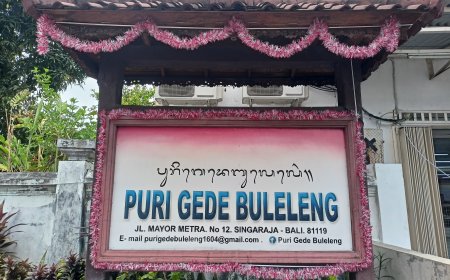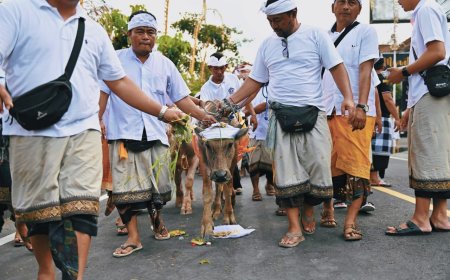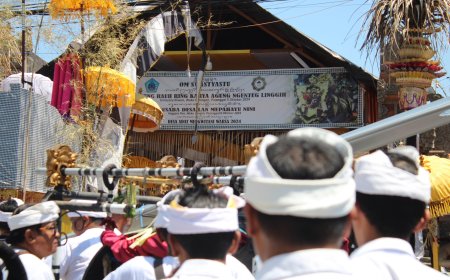Ngusabha Desa: The Golden Opportunity for Ida Bhatara Guru to 'Ngeyasang' Each Family
Ngusabha Desa, which means Negtegan Bhumi, is an important ritual in Balinese tradition aimed at stabilizing the condition of the earth or environment and achieving social and spiritual welfare for the community. The presence of Ida Bhatara Guru as the highest authority in the family holds significant importance in this Ngusabha Desa.
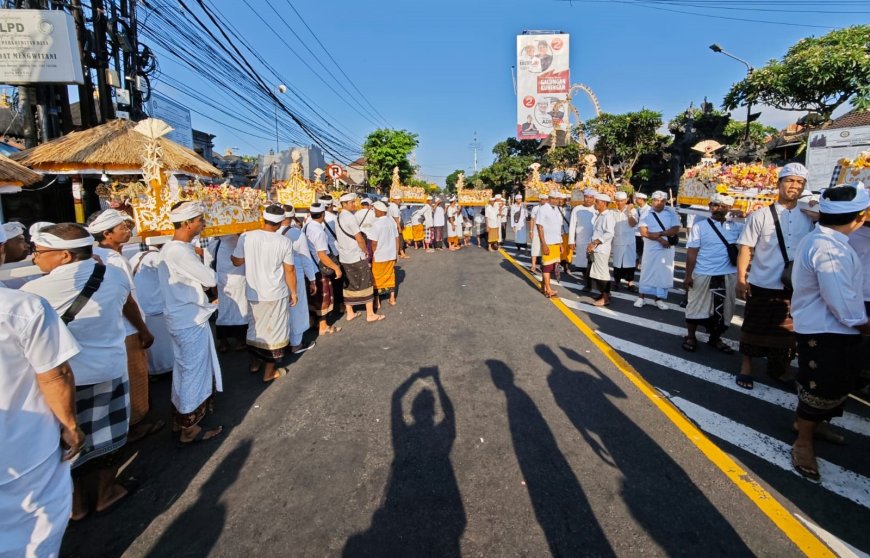
In the lontar Widhi Sastra, it is mentioned that Ngusabha Desa means "Negtegan Bhumi," referring to the purpose of Ngusabha Desa itself, which is to stabilize or strengthen the state of the earth or the environment, in order to address various issues faced by the community. This important ritual serves as an effort to achieve social and spiritual welfare. Ngusabha Desa also reflects the collective spirit, where the word "Ngusaba" means to gather/together, emphasizing that togetherness is the foundation of this ritual. In a specific context, this gathering can also mean a meeting.
In the context of Ngusabha Desa, the socio-spiritual condition of the community is represented by the socio-spiritual condition of each family. Every family inevitably experiences sorrow or suffering. This suffering can stem from samsara (reincarnation) or from free will in living life. This is the essence of the presence of Ida Bhatara Guru in Ngusabha Desa, who holds the highest authority over family life. Ngusabha provides a golden opportunity for Ida Bhatara Guru to "Ngeyasang" each family, meaning to connect each family with a higher spiritual authority. Through this process, Ida Bhatara Guru seeks and petitions for guidance for each family member in overcoming their suffering, with the hope that all forms of suffering will find a resolution. Certainly, this "Ngeyasang" is not only related to suffering but also to the broader hopes or aspirations of each family member.
There is a question: if Ida Bhatara Guru is not present, can a family still have the opportunity for "ngeyasang"? In this context, the concept of such a grand work involves presenting the Gods and the Bhatara so that they can meet physically in various forms or symbols (such as statues, daksina linggih, etc.). This principle must be upheld. One can imagine this as an opportunity for the community to meet high officials or great leaders in person, where such interactions carry deeper meaning. If the context is that the Gods or Bhatara simply reside in the spiritual realm without physical meeting, then such a grand work is unnecessary.
Ngusabha Desa also functions as a moment of reflection for the community, inviting each individual to be grateful and celebrate all the gifts of life they have received, while committing to create harmony. By emphasizing togetherness, this ritual not only strengthens spiritual bonds but also fosters a sense of solidarity and mutual support among village residents.
The Ngusabha Desa ceremony at Bale Agung, Pura Desa Mengwitani, on October 8, 2024, featured 648 Ida Bhatara Guru from both Merajan Wayah and Carang from each family. To facilitate the execution on the ground, all the Bhatara Guru were divided into 30 groups based on the wewidangan of 15 banjar.
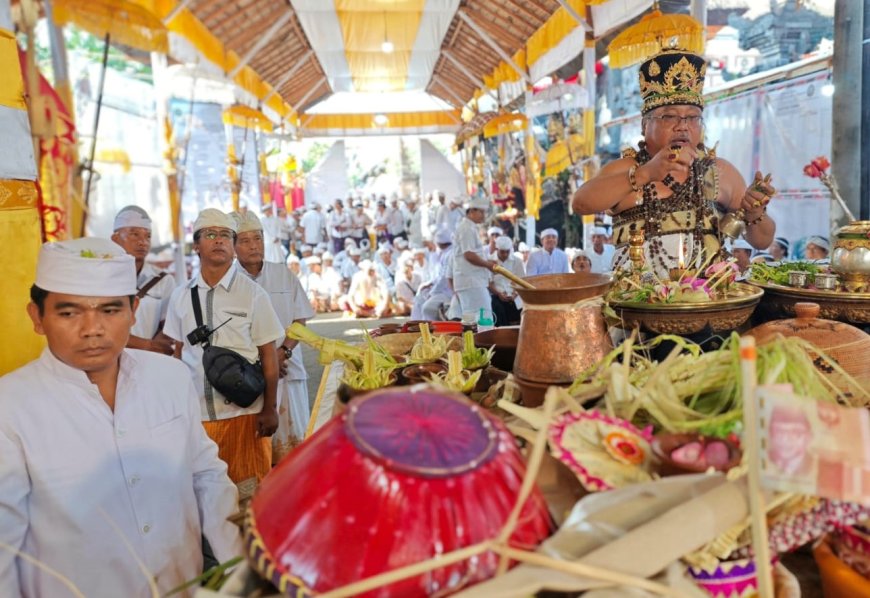
Ida Mpu Dukuh Samiaga Led the Antaran Kambing Ceremony
The Ngusabha Desa procession began with the Nganteb ceremony of Antaran Kambing at 07:00, led by Ida Mpu Dukuh Samiaga from Griya Samiaga Penatih. After this Nganteb ceremony was completed, it continued with the Ida Bhatara Guru Murwa Daksina procession, where Ida Bhatara Guru descended and circled Bale Agung three times. On the third round, Ida Bhatara Kahyangan Tiga, the highest spiritual authority in the Desa Adat, descended (tedun) in procession towards Bale Agung, stepping on the Antaran Kambing, followed by other Ida Bhatara Guru, before everyone ascended (munggah) to Bale Agung. After this procession was completed and Ida Bhatara Kahyangan Tiga along with all Ida Bhatara Guru had taken their places (melinggih) in Bale Agung, the Ngusabha Desa ceremony commenced.
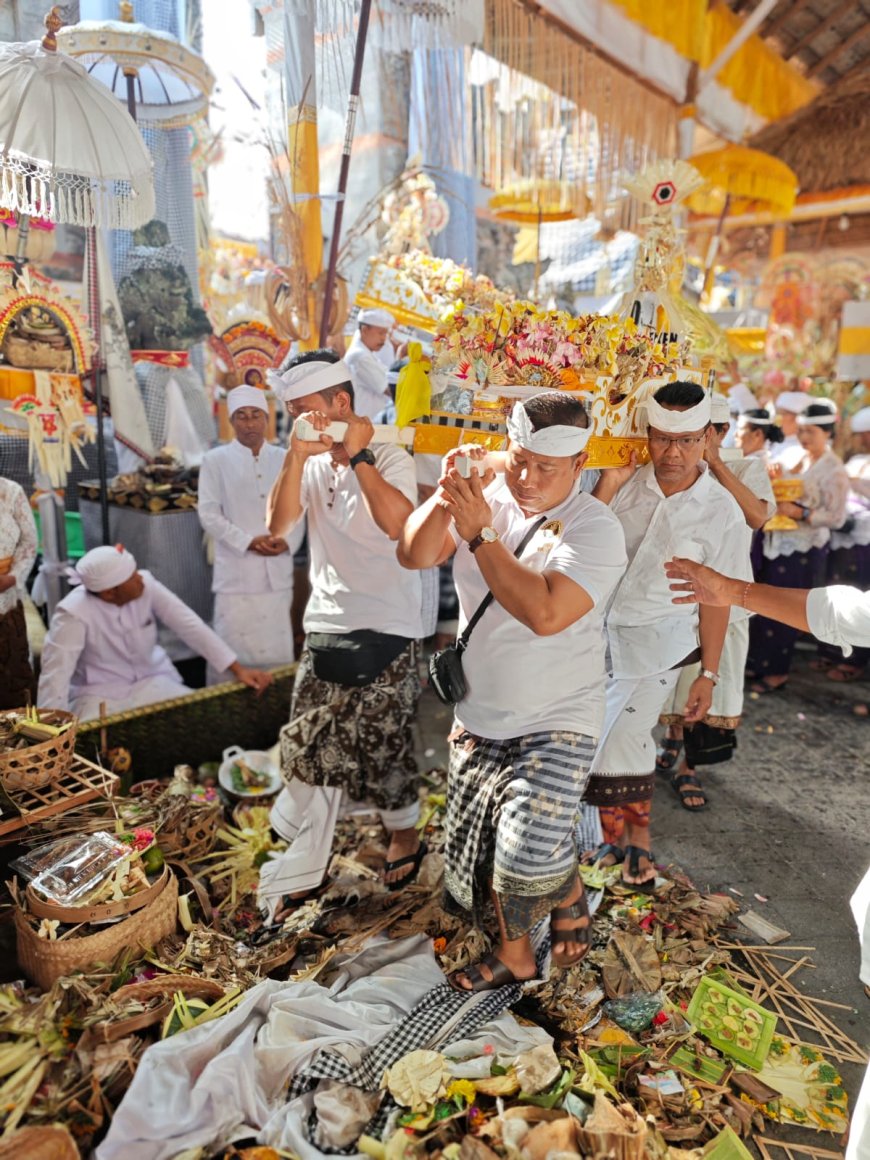
Ida Bhatara Guru made a symbolic walk during the Antaran Kambing before ascending to Bale Agung.
The Ngusabha Desa ceremony started around 09:00, led by five Sulinggih: Ida Pedanda Gede Buruan from Griya Darmasabha, Ida Pandita Mpu Sastra Wedangga from Griya Sembung, Ida Bhagawan Geniten from Griya Taman Abiansemal, Ida Rsi Hari Dantam from Griya Tumbak Bayuh, and Ida Mpu Dukuh Samiaga from Griya Samiaga Penatih. This can be regarded as a historic moment for Desa Adat Mengwitani, where the Karya Agung was officiated by the Sulinggih from the "Sarwa Sadhaka" community.
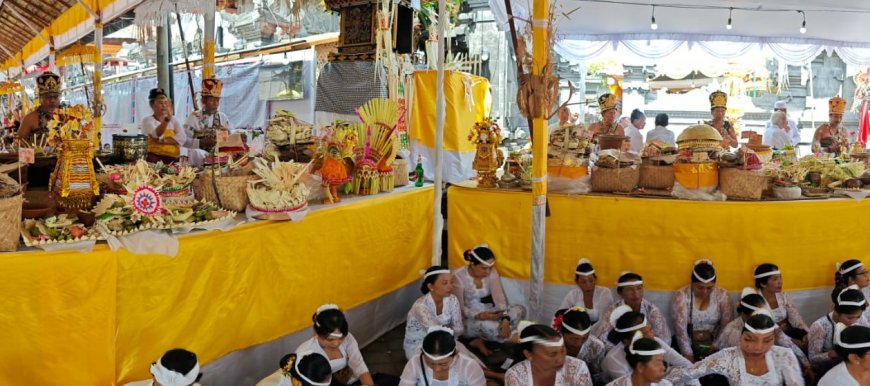
Five Sulinggih led the Ngusabha Desa ceremony at Pura Desa Puseh Mengwitani.
Through this golden opportunity, Ida Bhatara Guru can provide blessings, alleviate suffering, and lead each family towards welfare. Ngusabha Desa becomes a symbol of the collective commitment of the Balinese community to maintain social and spiritual balance, making this ritual an important aspect of their lives.



















































